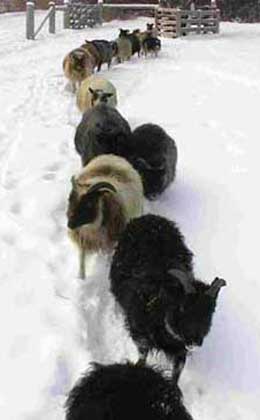About Icelandic Sheep
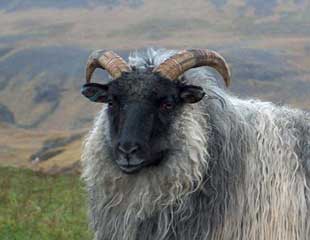
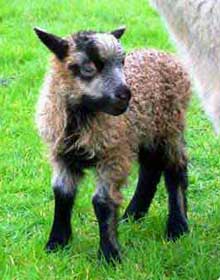
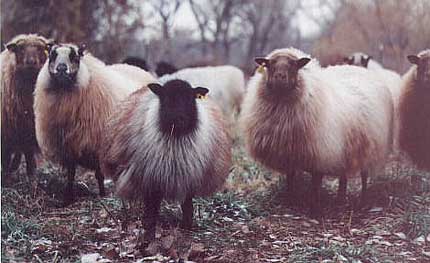
Meat Production
Though famous throughout the world for wool production, the Icelandic breed is predominately grown for meat in Iceland. Since the cool and wet climate precludes the production of most grains in Iceland, the breed has been selected to bring the meat lambs to slaughter weight off of the summer and fall pastures. Icelandics are very adaptable, and can be handled in a variety of management plans. Here in North America they thrive on grass-based farms where they are rarely fed grain, to dry-lot situations where they are fed daily, and all the management systems in between.
Market lambs will start to reach their ideal slaughter weights of 70-100 pounds at four to five months. With continued access to quality graze, the lambs can be slaughtered directly off the grass all through the fall months. This has positioned the Icelandic breed to fit well in the move towards grass-based farming, enabling “natural” and organic farmers to utilize the Icelandic breed. As meat consumers increasingly recognize the health benefits of grass fed meats, and as economic pressures drive our farmers toward grass-based businesses, the genetics of the Icelandic breed become increasingly valuable to our sheep industry.
The Icelandic breed is considered a mountain breed, and historically mountain breeds have been milder in flavor, and leaner than the lowland breeds. The meat is indeed very tender with a mild flavor, and is generally described as gourmet meat. With the leaner, European style carcass, and the mild flavor, Icelandic lamb can appeal to the palate of even those consumers who avow they "just don't like lamb." With the combination of the economic and market advantages of grass fed farming, and with the appeal of the delicious flavor, the Icelandic breed is a natural for direct-to-consumer marketing.
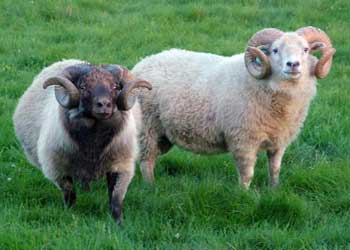 Fiber
Fiber
The Icelandic sheep produces a premium fleece. The fleece is dual coated, with a fine, soft undercoat called thel and a longer, coarser outer coat called tog. The tog fiber with a spinning count of 56-60 and a micron count of 27-30, grows to a length of 6-8" in six months. It is lustrous, strong, water- and wear-resistant, and sheds off the rain and weather. Thel is the soft downy undercoat, with a spinning count of 64-70 and a micron count of 19-22, growing to a length of 2-4". The thel provides the loft for the outer coat and insulation for the sheep. Tog grows from the primary hair follicles and the thel from the secondary follicles. Tog is a true wool, and is not a kemp or guard hair. The combination of the two fibers on the sheep gives superb protection from the cold and wet. Icelandic fleeces are open and low in lanolin. The weight loss when washed is significantly less than many other breeds.
The average adult yearly fleece total weighs 4-7 lbs. Producers often shear their Icelandics twice a year. This is due, in part, to the fact that Icelandics have a natural wool break in late winter for the rams generally, and in spring for the pregnant or lactating ewes. Shearing at or around the time of the natural break is recommended to remove the "old" coat before the "new" coat grows in. The sheep are sheared again in the fall to harvest the fleeces before the animals go on hay for the winter. These fall-shorn fleeces are very soft and clean and can bring a premium price per pound.The two coats can be separated by hand for special projects, or they may be processed together. The traditional lopi is a lightly spun blend of tog and thel. Thel is very soft and downy, with an irregular crimp and can be used for baby garments, and for the fine shawls in the style of the Wedding Shawl. The tog is similar to mohair; wavy or corkscrewed rather than crimped and is wonderful in worsted spinning.The versatility of the wool, the ease of spinning and the wide variation of tones and colors are a true delight to handspinners, and put Icelandic wool into the exotic or premium category. It is also known as one of the best fleeces for felting, which is fast gaining popularity in the craft community.
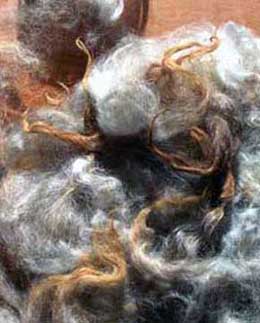
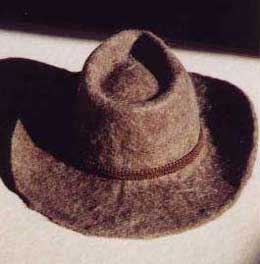
Milk
Icelandic ewes easily support twins and many raise triplets without assistance. In North America, they are used for personal milk production by many shepherds for yogurt and soap. Some farms are making gourmet artisan cheeses. There are a few operations milking more than 25 sheep, but long-term production records are not yet available. Crossing Icelandic sheep with commercial dairy breeds is also being investigated. For personal use, it is possible to allow lambs to continue to nurse while milking once per day, without sacrificing lamb growth.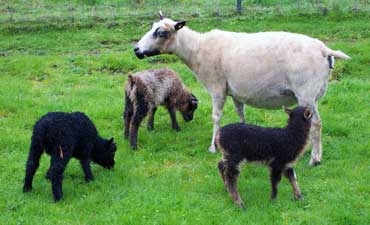
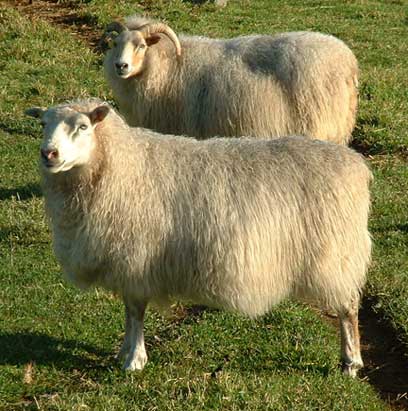 Pelts
Pelts
The pelt of the Icelandic sheep is beautiful, lustrous, soft and luxurious, in a delightful range of colors and patterns. The relatively low number of follicles per square millimeter, a count of 12 rather than the 53-87 of the Merino sheep, for example, makes the pelt soft and flexible. These pelts command a high price in that niche market.
Registration
In North America, Icelandic sheep are registered with ISBONA through the Canadian Livestock Records Corporation, known as the CLRC. Registrations can be done via surface mail, or electronically, and requires tattooing or tagging the sheep in a manner accepted by ISBONA. As defined by the by-laws of ISBONA, the breed association recognizes the registry of Icelandic sheep only through the CLRC.
Leadersheep
"Some people may argue that sheep are not intelligent and clever. However, it is well known that sheep have their own intelligence although not comparable with that of people. We should not underestimate the wisdom of domestic animals anyway. The only breed of sheep in Iceland is the native North European Short Tailed sheep brought there by the settlers, the Vikings, 1100-1200 years ago. Without them Icelanders would not have survived throughout centuries of hardship on an isolated island just south of the Arctic Circle. Even grazing in winter had to be utilized to the utmost and somehow a unique, small population of sheep developed which displayed outstanding abilities to help the farmers and shepherds to manage the flock on pasture, namely leadersheep. Although farming practices have changed and thus the role of these highly intelligent sheep with special alertness and leadership characteristics in their genes, there is still a population of 1000-1200 sheep within the national population of just under 500,000.
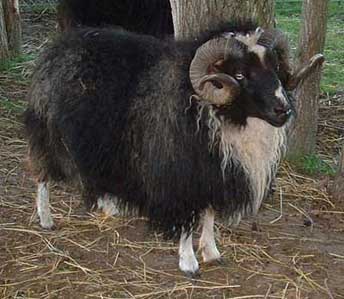
Most of the leadersheep are coloured and horned, even four-horned in a few cases. They have a slender body conformation, long legs and bones generally, yet of lighter weight than other sheep in the flock because they have been selected for intelligence, not for meat traits. Leadersheep are graceful and prominent in the flock, with alertness in the eyes, normally going first out of the sheep-house, looking around in all directions, watching if there are any dangers in sight and then walking in front of the flock when driven to or from pasture. They may even guard the flock against predators. There are many stories on record about their ability to sense or forecast changes in the weather even, refusing to leave the sheep-house before a major snowstorm. One wonders how better use could be made of such genes in the future.
We certainly want to preserve the Icelandic leadersheep. Interested individuals founded the Leader-Sheep Society of Iceland in April 2000. Amongst the priorities is to improve the individual recording of these sheep throughout the country and plan their breeding more effectively. We know that the best leadersheep are found in flocks in NE Iceland but farmers in all parts of the country are interested in their conservation. Support is also coming from individuals who are not keeping sheep. Icelandic sheep, not least leadersheep, have clearly a special role in our culture."
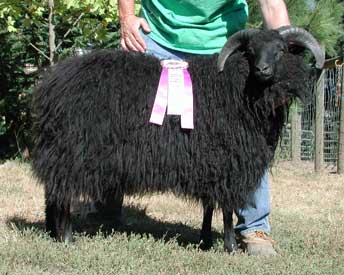
Written by Dr. Olafur R. Dyrmundsson, The Farmers Association of Iceland
Members are welcome to reproduce this material on their own websites with a credit/link to ISBONA and this site.
- Download trifold brochure with photos (PDF)
- Download PDF of this page (Text Only)
- Color, Genetics and Coding (PDF)


